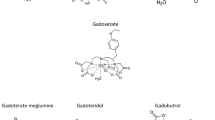Abstract
Rationale and objectives: Gadomer-17 is a new magnetic resonance (MR) contrast medium presently in clinical development. It is a dendritic gadolinium (Gd) chelate carrying 24 Gd ions. This study investigated the pharmacokinetic behavior of this contrast medium. Methods: The pharmacokinetics of Gadomer-17 were investigated in different species (rat, rabbit, dog, monkey) for up to 7 days after intravenous (i.v.) injection of 25–100 μmol/kg body weight. In addition, elimination and biodistribution were evaluated after single i.v. injection of Gadomer-17 in rats. Results: After i.v. injection Gadomer-17 distributes almost exclusively within the intravascular space without significant diffusion into the interstitial space. The volume of distribution (Vc) in the initial or α-phase ranged from 0.04 1/kg (rats, rabbits) to 0.06 1 kg (monkeys) and 0.07 1/kg (dogs), which reflects mainly the plasma volume. The blood/plasma concentration profile was found to be biphasic. The volume of distribution at a steady state is clearly smaller than that of other contrast media, which distribute to the extracellular space. After single i.v. injection in rats, the dendritic contrast medium was rapidly and completely eliminated from the body, mainly via glomerular filtration. No long-term accumulation or retention of the nonmetabolized agent was detectable in organs or tissues. Conclusions: Gadomer-17 is a promising new MR contrast medium that has an intravascular distribution and a rapid renal elimination.
Similar content being viewed by others
References
Prince MR. Gadolinium-enhanced MR aortography. Radiology 1994;191:155–64.
Prince MR. Grist TM, Debatin JF. 3D contrast MRA. Berlin: Springer, 1997.
Ho KY. Leiner T. de Haan MW. et al. Peripheral MR angiography. Eur Radiol 1999;9:1765–74.
Knoppp MV. von Tengg-Kobligk H, Floemer F, et al. Contrast agents for MRA: future directions. J Magn Reson Imaging 1999;10:314–6.
Bongartz GM, Boos M, Winter K, et al. Clinical utility of contrast-enhanced MR angiography. Eur Radiol 1997;7(Suppl. 5):S178–86.
Brasch RC. Rationale and applications for macromolecular Gd-based contrast agents. Magn Reson Med 1991;22:282–7.
Harika L, Weissleder R, Poss K. et al. MR lymphography with a lymphotropic Tl-type MR contrast agent: Gd-DTPA-PGM. MRM 1995;33:88–92.
Adam G, Mühler A. Spuntrup E, et al. Differentiation of spontaneous canine breast tumors using dynamic magnetic resonance imaging with 24-gadolinium-DTPA-cascade-polymer. a new blood-pool agent: preliminary experience. Invest Radiol 1996;31:267–74.
Mühler A. The future of contrast-enhanced magnetic resonance angiography. Are blood pool agents needed? Invest Radiol 1998;33:709–14.
Misselwitz B., Platzek J, Radüchel B, et al. Gadofluorine 8: Initial experience with a new contrast medium for interstitial MR lymphography. MAGMA 1999;8:190–5.
Clarke SE. Weinmann H-J, Dai E, et al. Comparison of two blood pool contrast agents for 0.5-T MR angiography: experimental study in rabbits. Radiology 2000;214:787–94.
Parmelee DJ, Walovitch RC. Ouellet HS, et al. Prechnical evaluation of the pharmacokinetics. biodistribution, and elimination of MS-325, a blood pool agent for MRI. Invest Radiol 1997;32:741–7.
Lautier RB, Parmelee DJ, Dunham SU, et al. MS-325: albumin-targeted contrast agent for MR angiography. Radiology 1998;207:529–38.
Kellar KE, Fujii DK, Gunther WH, et al. NC100150 injection, a preparation of optimized iron oxide nanoparticles for positive-contrast MR angiography. J Magn Reson Imaging 2000; 11:488–94.
Schmiedl U, Ogan M, Paajanen H, et al. Albumin labeled with Gd-DTPA as an intravascular, blood pool-enhancing agent for MR imaging: biodistribution and imaging studies. Radiology 1987;162:205–10.
Marchai G, Bosmans H, Van Hecke P, et al. MR angiography with gadopentetate dimegluminepolylysine: evaluation in rabbits. Am J Radiol 1990;155:407–11.
Wang SC, Wikstrom MG, White DL, et al. Evaluation of Gd-DTPA-labeled dextran as an intravascular MR contrast agent: imaging characteristics in normal rat tissues. Radiology 1990;175:483–8.
Schuhmann-Giampieri G, Schmitt-Willich H, Frenzel T, et al. In vivo and in vitro evaluation of Gd-DTPA-polylysine as a macro-molecular contrast agent for magnetic resonance imaging. Invest Radiol 1991;26:969–74.
Loubeyre P, Canet E. Zhao S, et al. Carboxymethyl-dextran-gadolinium-DTPA as a blood-pool contrast agent for magnetic resonance angiography: experimental study in rabbits. Invest Radiol 1996;31:288–93.
Roberts HC, Saeed M. Roberts TP, et al. Comparison of albumin-(Gd-DTPA)30 and Gd-DTPA-24-cascade-polymcr for measurements of normal and abnormal microvascular permeabilit. J Magn Reson Imaging 1997;7:331–8.
Dong Q, Hurst DR, Weinmann H-J, et al. Magnetic resonance angiography with Gadomer-17: an animal study original investigation. Invest Radiol 1998;33:699–708.
Weinmann H-J, Ebert W, Misselwitz B, et al. A new dedicated contrast agent for MR angiography. Eur Radiol 1997;7(Suppl.):S196.
International Patent Application: WO97/02051.
Dittmer DS, editor. Biological handbooks: blood and other body fluids. Washington, DC: Federation of American Societies for Experimental Biology, 1961.
Adam G, Neuerburg J, Spuntrup E, et al. Gd-DTPA-eascade-polymer: potential blood pool contrast agent for MR imaging. J Magn Reson Imaging 1994;4:462–6.
Wiener EC, Brechbiel MW, Brothers H, et al. Dendrimer-based metal chelates: a new class of magnetic resonance imaging contrast agents. Magn Reson Med 1994;31:1–8.
Corot C, Violas X, Robert P, et al. Pharmacokinetics of three gadolinium chelates with different molecular sizes shortly after intravenous injection in rabbits. Relevance to MR angiography. Invest Radiol 2000;35:213–8.
Author information
Authors and Affiliations
Rights and permissions
About this article
Cite this article
Misselwitz, B., Schmitt-Willich, H., Ebert, W. et al. Pharmacokinetics of Gadomer-17, a new dendritic magnetic resonance contrast agent. MAGMA 12, 128–134 (2001). https://doi.org/10.1007/BF02668094
Received:
Revised:
Issue Date:
DOI: https://doi.org/10.1007/BF02668094




